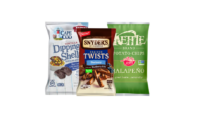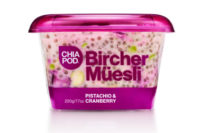Gone are the days of the structured, three-a-day meals and the unhealthy reputation of snacks. Hectic, on-the-go routines have people looking for ways to get some sustenance during the day in a quick and convenient way. Nutritious snacks fit the bill.
The fast-moving millennial generation reshaped the snacking industry by voicing its need for quick and convenient meals throughout the day. Millennials, likely to snack more than any other generation, make up a portion of a group Mintel identifies as “super snackers,” or those who snack four or more times in a single day.
Their behaviors are driven by busy schedules and the preference to eat whenever the opportunity arises. To millennials, the purpose of snacking can range from a healthy meal alternative to sustenance between larger meals or simply a satisfying treat.
When most brands think of the word “snacking,” single-serve format packaging typically comes to mind. However, as millennials start to grow up, it is vital to understand how their lifestyles shape new preferences and what that means for the packaged snack industry.
The Tale of Two Millennials
Millennials are defined as anyone born between 1981 and 1996, which means this year, millennials are between the ages of 22 and 37. That large age gap is precisely the reason experts often divide the generation into “older millennials” (1981-1988) and “younger millennials” (1989-1996). While millennials, young and old, are all avid snackers, they have substantially diverse needs.
Younger millennials are more likely to be focusing on travel, experiences and landing their dream job. Their lifestyles are busy, and they are constantly on the go. This group is typically buying food for only themselves when grocery shopping. What’s more, shopping in bulk is less appealing because the package contents are likely to go bad before they finish it. This group craves convenience, and single-serve or smaller-sized snack pouches suit their needs extremely well. They’re fans of throwing pre-made snack pouches in their purse or bag, eating on the go and are willing to pay a premium for convenience.
Older millennials are more likely to have their own families, own a house and are juggling raising their kids while working. Recent studies support the idea that young moms and dads may be more likely to purchase larger packages of snacks at places like warehouse club stores and supercenters. Nielsen research shows that while protein snacks such as jerky may be a common convenience store impulse buy, 24 percent of purchases occur at supercenters and 20 percent at warehouse clubs. This behavior extends to other snack categories as well.
Regardless of the millennial segment, the generation as a whole is growing up and shifting towards a time in their lives where they are settling down and having families. With that comes the need for different snack packaging formats to suit their lifestyle.
How Closures Can Seal the Deal
To seal the deal with these two buying groups with a massive amount of purchasing power, package size comes into play. While younger millennials are looking for smaller package sizes, it does not necessarily mean that they won’t purchase multi-use snack pouches. Consider smaller size packages with two to three serving sizes that will last an entire workday or longer.
Previously, press-to-close zippers were the only option for reclosing small format pouches. However, new options such as small format sliders now exist to complement small and uniquely shaped pouches.
If your package has more than one serving, resealability should be a consideration. Consumers have come to expect these features in packaging. If a package doesn’t perform to standards due to spills or product going stale, they will choose another brand.
The Flexible Packaging Association’s 2015 Brand Value research indicated that “resealable” and “easy to open” were among the top three attributes that packaging should deliver. This is not only important for small snack pouches, but large format pouches as well.
To win with the older millennials searching for family-sized snacks, make your packaging easy for them to store. No one likes having to repackage product into different bags and containers if the primary packaging wasn’t resealable, which is why FPA research proved that 70 percent of parents would pay more for an easy-to-store package.
In addition, busy moms and dads need grab-and-go snacks as well. Whether they grab a small snack pouch or a larger package for a day at the park, they don’t have the time or patience to pick up contents that spill in their cars or bags.
Easy reclose options not only help them keep their bags clean, it’s easy for children to open and self-serve when they’re driving. New developments also help consumers like busy moms and dads find assurance that their package is fully closed and won’t spill. Audible snaps and noticeable textures between closing zippers cue parents and help teach children that the package is fully shut.
It’s All About Enhancing Consumer Experience
In order to win at the shelf with multi-use snack packaging, you need to put the shopper first. Consider how millennials will interact with the package, who they will (or won’t) share it with, where it will be stored and what size the package should be. Based on their needs, you can determine the size of the package, what type of closure or fitment adds value and how all that ties together with your brand.
Mintel reported that one-third of U.S. adults agree there are not enough conveniently packaged snacks. Brands, packagers and retailers have an opportunity to distinguish their offerings with packaging that provides convenience and functionality. By considering the consumers’ needs and carrying them through in all aspects of your snack packaging, you are sure to create an experience that will not only win on the shelf but will produce loyal customers as well.
Presto Products




